
NEW IMAGESCinesite’s VFX team takes 007 on a chase through the London Underground and brings him face to face with a Komodo dragon in ‘Skyfall’.
Skyfall Station |
|
After the main shoot for ‘Skyfall’ got started in November 2011, Cinesite’s VFX Supervisor Jon Neill set to work with his team on their sequences deep in the London Underground in January 2012. They worked on a series of scenes following Bond as he pursues the villain Silva into the underground system, taking on a harrowing chase through the tunnels and culminating in a spectacular crash. The team’s task was to combine live action plates shot in a closed off, disused section of railway with action shots staged at the 007 stage at Pinewood Studios, and enhance the composites with 2D and 3D elements and extensions, ultimately constructing the full sets as seen in the film. Charing Cross ChaseThe disused section of railway, located at Charing Cross along the Underground’s Jubilee Line, is still functional and has a complete platform, allowing the production to bring in a train and hundreds of extras. Most of the fully live action, non-VFX shots could be done there, for example, as Bond moves through the crowd to board the train. |
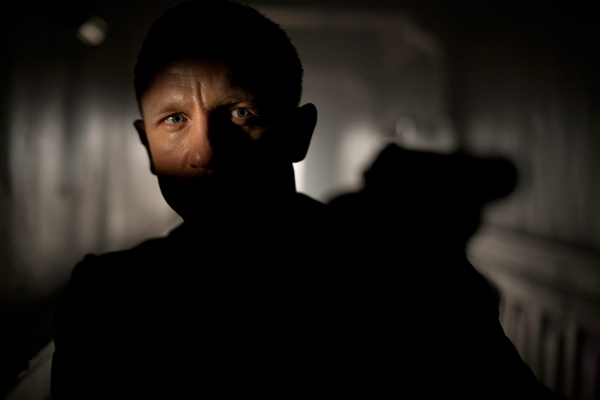 |
|
For the high action shots, the shoot operations moved to Pinewood Studios where the production took advantage of the massive 007 stage to build a large section of platform corresponding to the live action. One half of a practical train was also constructed and placed on the rails for the actor to jump onto the back of. Multiple, variously placed cameras were used to capture the scenes at different angles. One camera, for example, was located inside the carriage looking out at Bond as he held on to the back. The ability to have so many cameras running throughout gave the editors a chance to cut between them and make the sequence very exciting. Green screen was positioned at the ends of the platform and where the tunnel would be for digital extensions in post, but the preference was always for using the large set build as much as possible. “In the tunnel areas, in fact, grey screens were used,” said Jon O’Neill. “The DP Roger Deakins dislikes green screens and only resorted to them when he had no choice, for flexibility. But because those tunnel areas were quite dark, going with grey and rotoscoping the live action worked well. “Because no extras were used on the Pinewood set, we had to add them later in post. After working out the camera angles in Maya in advance, a large green screen element of passengers was shot. The crew used three cameras at different heights, providing us with footage to handle any perspective changes arising in the edit later on.” |
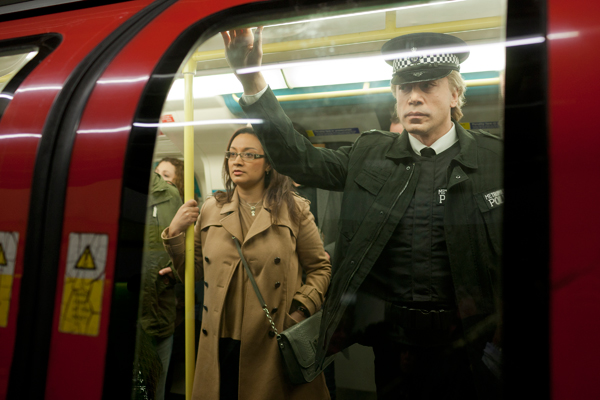 |
Set ReconstructionOn set at the Charing Cross set, the team captured a full set of reference images. They also measured the tiles on the wall and adopted this measurement as a scale reference across all images. Then on the Pinewood set, they captured photogrammetric data, panoramas and another extensive set of measurements. All of this material and data allowed them to construct the full set seen in the film, combining elements from both shoots and adding digital assets where required. Owing to the complex nature of the shoot and the editing job that followed, the team received several versions of the cut throughout the project, and had to be prepared for changes. Jon said, “Textures were mapped onto the platform from HDR imagery captured on set. On location, the crew had relied only on the existing lights, and the crew on the Pinewood set could effectively copy them, resulting in a consistent lighting scenario, and that really helped us when we were bringing the elements together. “The HDR images were taken from camera positions on the platform and triangulated in 3D Equalizer. This allowed us to create an accurate model of the set that lined up in all camera views. The HDR was projected back on to this geometry and baked off as floating point TIFs into UV space, cleaned up and graded in Photoshop. This meant we had reflections that matched the plate, and we could use the projection to extend the platform environment as well.” |
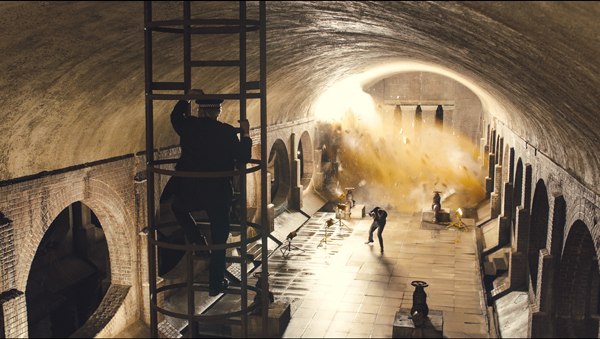 |
Train and Tunnel DesignWhen creating the extra train carriages, viewed from Bond’s carriage extending back down the tunnel, the team found the Art Department’s train had a different design from the real Tube trains they had photographed as reference for their models, which meant carefully lining up the windows and replacing portions of the practical train in the images. But the important aspect for these carriages was, again, the reflections, which were controlled by raytracing and depended on the accuracy of the tunnel environment they were passing through. Fortunately, the tunnel set extended about a third of the way along the distance and could be used as a start point for creating the lights on the set walls, and especially light effects and slight lens flares, copied in the CG work. “By building a 3D mesh-cache, we were able to work within Nuke’s compositing pipeline and address changes quickly. Both photography and matte painting textures were projected onto this, and tracking data enabled us to line up accurately to the original set,” Jon explained. “Then, we could use Nuke 3D lighting to assist the projected matte painting. This was created and rendered out complete with a variety of passes built into the open EXR format. The compositors tuned specific elements within the tunnel pass, similar to the way a pass from 3D lighting would have allowed.” The team produced a number of full 3D shots within the sequence, and where these shots contained camera motion they took a frame from the 3D to use as a matte painting and applied the lighting undulations on top. At one point, the tunnel on the set curves so much that it became obvious to director Sam Mendes that the audience would expect a real train moving at the required speed to de-rail. In 3D, they straightened up the tunnel by replacing an extra portion of the real set. The result not only needed to look real and integrated, but also had to work for the action, the cut and for the train. Damage ControlNo ordinary train crash, the incident in this film was staged practically, at full scale, by Skyfall’s special effects team. It starts with an explosion and sends a train through the ceiling toward James Bond. Back in November 2011 at the time of bidding, Cinesite had seen previs of the crash. The production decided to build and blow up a full size set piece to shoot the sequence, and as the set went up, Cinesite’s team followed to photograph all structures and texture references. They surveyed the entire set in order to build a full 3D model, and to complete the extensive digital clean up and enhancement stage that followed. |
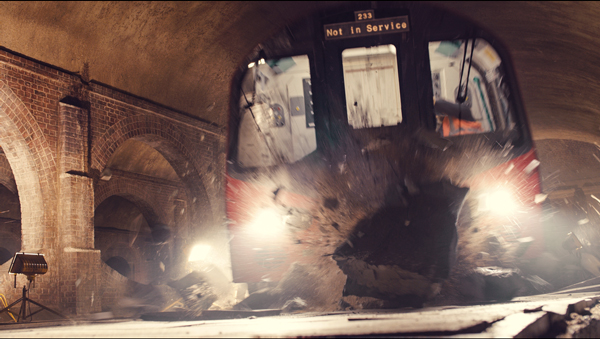 |
|
Jon explained the procedure. “When the train enters through a hole torn in the ceiling, it is suspended from brackets to ‘fly’ into the set, crash through the hole and hit the floor. It meanwhile rips a big path right across the ceiling. The clean up here was substantial – the path, the brackets and their dust trails all had to be removed. We composited a driver into the train, and when the practical set burst apart much of the polystyrene was exposed and had to be disguised as brickwork. “Also, as the train advanced toward the built set, which was a massive structure, before the smash it all began to shudder, behaving like plywood, of course, and not like brickwork. This effect required post stabilization by replacing parts of the sequence with single frames. The explosions were all real, and we added or enhanced the resulting dust and debris.” Ten CamerasReturning to the fact that this sequence was captured with ten ARRI ALEXA cameras, the team had no way of anticipating how the editor would choose to cut it together. They realized that trying to introduce green screen elements wouldn’t serve much purpose because having green screen on set would only have interfered with the camera set-ups, and the whole point of using so many cameras was having more freedom in the edit. Consequently they changed the way they worked somewhat. For example, in a key shot, the audience sees Bond as the explosion goes off. Later, because Bond and Silva had been photographed on set the day before the crash was staged, once the crash plates were captured the Bond element could be composited in just behind the fallen train. “This worked especially well because we had been able to capture his image in just the right lighting space,” said Jon. “We couldn’t have recreated it nearly so well on green screen. We could spend our time on a perfect roto, not the lighting. |
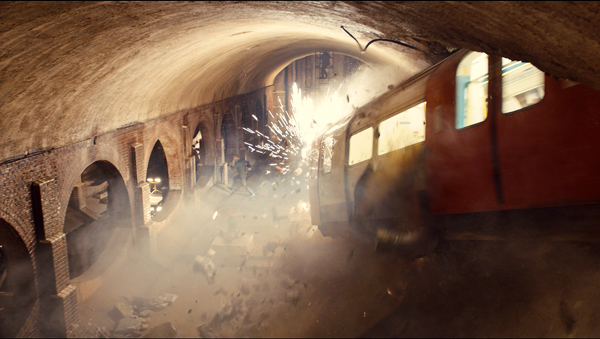 |
|
“Ten cameras meant removing a lot of cameras crew in post as well. At one point the crew ended up covering the lower half of Bond’s body which had to be replace with digital legs as well as the floor shadows and light interaction, all of which had been obscured behind crew members. “As the train crashes in from above, sparks fly and massive lighting effects go off in camera, causing complex shadows and complicating replacements of the set. The arches receding into the distance needed interactive light and shadow the whole time. Fortunately, those ten cameras also provided clean plates from every angle as well, which our artists used to make digital matte paintings to project onto 3D geometry. Whenever the crew- or any object - was in the way, they could replace the scene. We could also dissolve between bright, shadowed and darker versions of these in compositing to create looks of flashing light.” Tube SlideWhen Bond’s hot pursuit takes to the Tube escalators, the characters do not use the steps. Between the actual escalators inside the London Underground, the special effects unit built a large metal slide down over the existing structure, which includes sharp protrusions at the bottom that couldn’t be removed. The slide worked well for the actors slipping dramatically down the length of it but of course, it couldn’t be left in the plate. Photo elements of the original structure were composited back into the images. A bit like the tunnel work, extensions for the bottom of the escalator were achieved by building a simple 3D model which was textured with both matte painting and photographic projections. It could then be manipulated in Nuke’s 3D workspace as a mesh cache and altered on the fly to best match the set and the action in the plates. Adjustments could be made relatively quickly at the compositing end. |
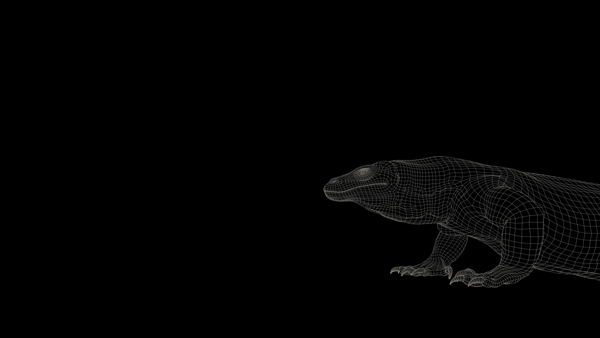 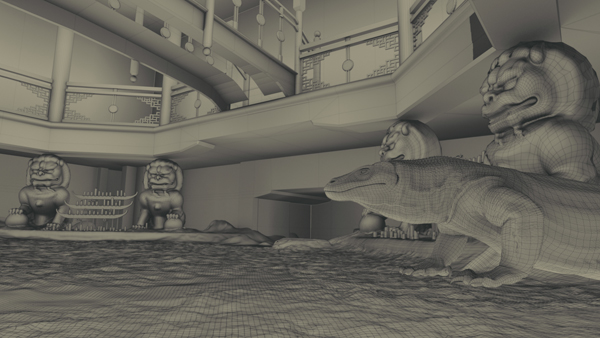 |
A Day at the ZooWith the goal of creating the first all-digital creature to ever appear in a Bond movie, Cinesite took a trip to the zoo with a photographer, where they had access to two Komodo dragons, an older male with a handler, plus a wild female that they could only watch and photograph without entering her enclosure. First, they set up a lighting system with a diffuser to create very flat, even lighting in the male’s enclosure where the photographer, with the handler, captured extreme close-up texture images. “The female was younger and more active and although we had to keep our distance, we could set up and sync two cameras in the enclosure, and shot footage of her movements for the animation while the handler threw in mice to encourage her to run about,” Jon said. “Being able to capture her from the two angles was extremely useful for letting the animators study each move from both sides. “For previs we had tried to use video of Komodos fighting, up on their back legs, which didn’t work so well from Sam’s point of view. Capturing and replicating a true reptilian performance was what he was after, the sudden moves between moments of motionlessness back in the shadows, so that no one sees them until the last moment.” |
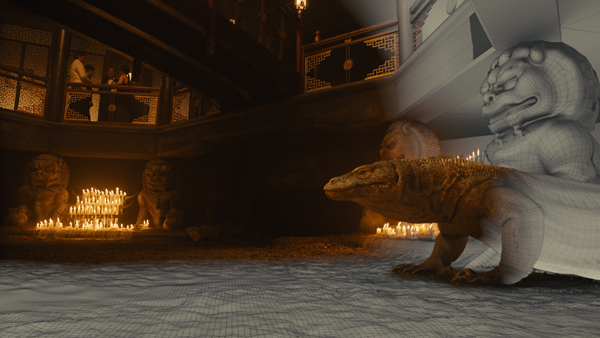 |
|
Nevertheless a request did come for a large establishing shot. Consequently, as 007 enters the casino, the audience sees a Komodo looking up from the pit below the floor level. They used this as their look development shot, meanwhile preparing all the animation, and when Sam approved the looks they could roll it out to all shots. HD Textures“What sells the Komodo’s realism in the shots are the beautiful HD textures,” Jon considered. “We created the textures in Photoshop and projected them with MARi. Maya and Mudbox were used to make extremely detailed displacement maps for the Komodo, but this made the model so heavy we had to take it in sections. The displacement maps were then created from these and brought together in the lighting stage. “Actually, letting these textures look too perfect simply didn’t suit the situation down in the pit. Only when we added a dirt layer to the belly and shoulders, leaving it cleaner over the top, did it truly come to life. We even shot reference of the gravel flicking up from the floor and used it to create a 3D effect of gravel kicking out from under their feet. |
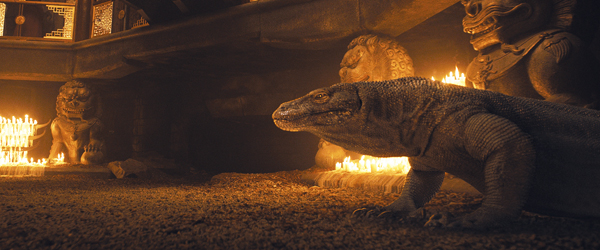 |
|
“We did have a LIDAR scan of their square pit at the casino and re-created a full 3D scene to build the dragons in. But of course the toughest shot was of the dragon going in for the bite because for some odd reason it persisted in simply looking like a model being pushed into frame – like a Komodo-on-a-stick, which is what we called it. Lighting, textures, animation – nothing we tried would fix this look.” Finally, up against deadline, they started from scratch. They re-animated and re-lit the whole shot, re-composited all components, and completed in just two days. The final shot was also a challenge, when the actor steps onto the Komodo. “On set, he steps onto a green box that isn’t moving although we have to move the dragon. It meant re-working the actual image to get his foot moving along in the same way.” No CompromiseDP Roger Deakins was quite mindful on set of the needs of the post and VFX teams as he shot, especially the way the light would behave. They didn’t hold dedicated meetings, but simply being on set and listening to his remarks about set ups for different shots was useful. After the Komodo shoot for example, he also reviewed the shots and gave the team some feedback. Jon said, “That was unusual and helped the team here avoid working at cross purposes to the camera crew. On set he had asked about using depth of field, rim lights and silhouetting on the creature’s body, to make sure he was handling it properly for our work. Likewise, during the crash sequence some operators wanted to protect the lenses with Perspex because they were so costly. But Roger said it wasn’t important – compromising the looks that way would be even costlier.”www.cinesite.com |
|
Words: Adriene Hurst |


















